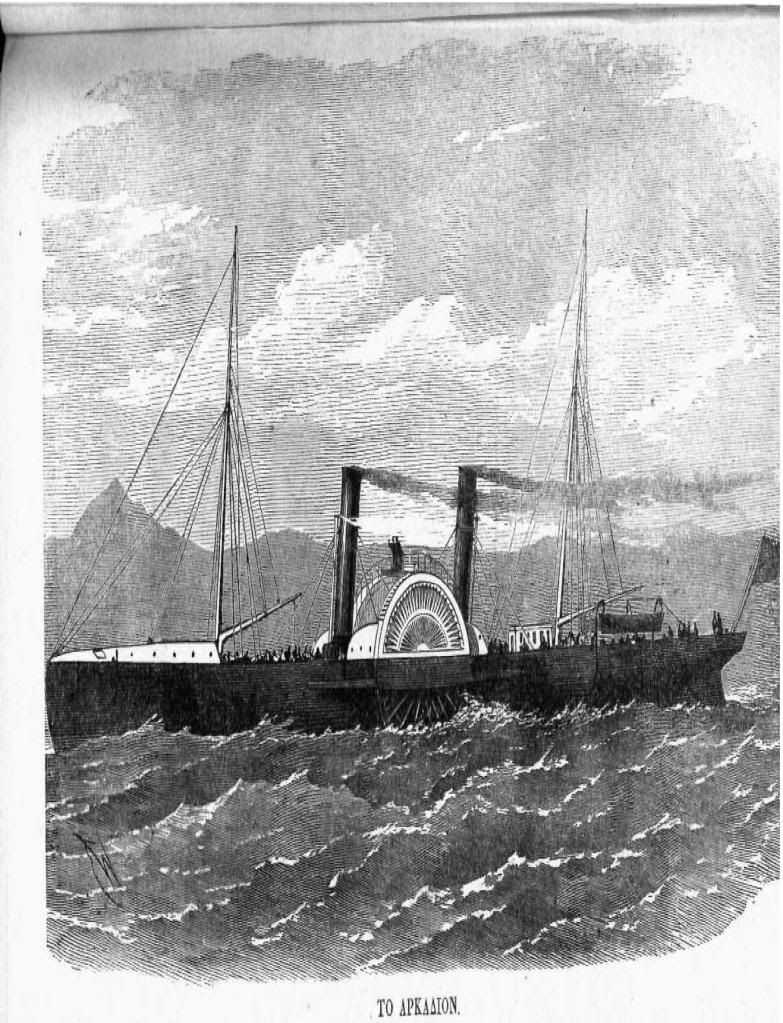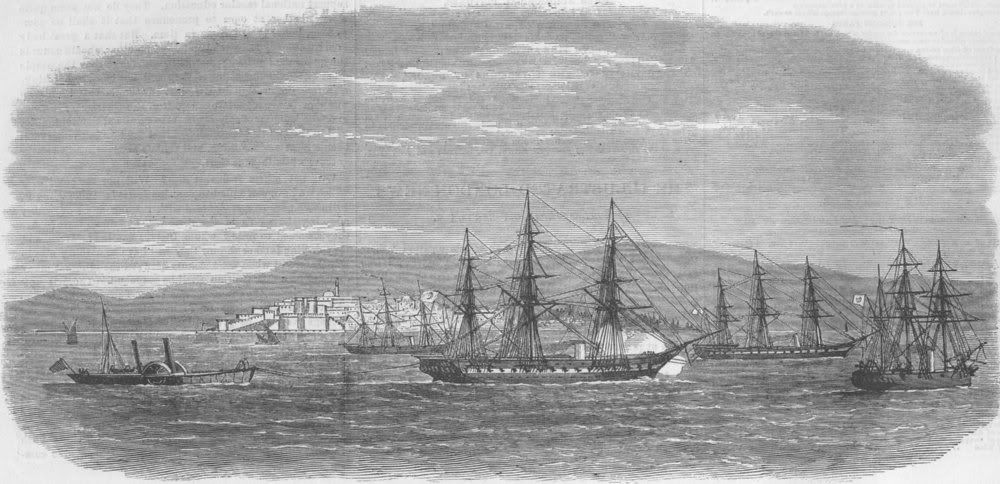One of the crucial events of the Cretan insurrection of 1866-68 was fought out just off the coast of Paleochora. The insurrection was sustained with arms and men from Greece and elsewhere delivered to the island by means of a number blockade runners; boats specially designed to be fast enough to elude the blockading Ottoman warships with a shallow enough draft to be able to use the smaller harbours. Without the continuous supply of men, arms and ammunition into the island and the evacuation of the wounded and of civilian refugees, carried out by these blockade runners, owned by private companies to provide deniability for the Greek Government, the uprising would have been over very quickly.
One of the most successful of these vessels was the Arkadion, named in honour of the Cretan Christian sacrifice at the Arkadi Monastery. Laid down in Liverpool by W. Potter & Son in 1866 and launched in 1867, she was originally intended to be a part of the Confederate Navy as CNS Dream, but, completed too late to see service, she was sold to the Greek Steam Navigation Company when the American Civil War ended.

The Arkadion
The iron clad Arkadion, a steam driven side paddle vessel, armed with six or seven guns, according to different reports, had made numerous successful trips to Crete up to August 1867; out-running and on one occasion out-gunning, pursuing Ottoman naval vessels. While the three contemporary accounts of her defeat published in English, those of the Arkadion’s commander, Captain A. Courantis, of Admiral Simon, Commander of the French Mediterranean Fleet, both of whom wrote eyewitness accounts, and that of Hassan Bey, commander of the Ottoman vessel Izzedin, whose account appears in the Ottoman Official Bulletin, vary in some of the details, they all tell the same story.
At 9pm on the evening of 20th August 1867, the Arkadion, en route from Gavdos to Agia Roumelli to complete the unloading of her cargo started the previous day, spotted the Ottoman Sloop Izzedin approaching from the south east. The Izzedin gave chase and with both ships exchanging cannon and rifle fire, the Arkadion sailed west past Paleochora and attempted to make out to sea after rounding Cape Krios. Very shortly after the Arkadion rounded Cape Krios, she sighted two other Ottoman warships coming towards her and at this point a shell from the Izzedin damaged the shaft of the starboard paddle wheel. With the starboard paddle wheel stopped, the Arkadion turned off her own accord and headed back east towards the pursuing Izzedin. With the Arkadion now having severe difficulty steering, as she came head on to the Ottoman vessel, the Izzedin rammed her on the starboard bow with the result that the two ships were locked together with their starboard paddle boxes jammed.
Rifle fire continued to be exchanged at close range for the next 15 minutes and three of the Arkadion’s crew attempting to board the Izzedin were killed in the hand to hand fighting. The Izzedin then backed off and, with the Arkadion still under fire and now in danger of sinking, Captain Courantis ran his ship aground near Cape Krios. Rifle fire continued and eventually at about 4am, Courantis, having suffered three killed, seven crewmen and 17 ‘volunteers’ wounded, evacuated his crew and passengers, set fire to the Arkadi and began the trek to Omalos and safety. The following morning, 21 August, the Ottomans put out the fire and stripped the Arkadion of her guns prior to carrying out a salvage operation on the grounded ship.
The Arkadion was eventually refloated and, amid much acclaim, towed into Constantinople on 21 September 1867 by the Imperial Steam Frigate Ertugul; she was refitted and as the Arkadi served in the Imperial Ottoman Navy until she was decommissioned in 1896, being sold for scrap in 1905.

Arkadion being towed into Constantinople
Hassan Bey was promoted from Commander to Captain and given a reward of 500 Lira, while the Chief and 2nd Engineers of the Izzedin, Mr J.Harty and Mr. Wilson, were awarded 200 and 120 Lira respectively. (It was not unusual to find British seamen serving in the Imperial Ottoman Navy at this time; the commander of the Ottoman blockade of Crete was Hobart Pasha: Augustus Charles Hobart-Hampden, formally a Post Captain in the Royal Navy.)

Hobart Pasha
As for Captain Courantis, he and his men reached Omalos after three days march from where he reported: “…I arrived with the other officers, the engineers and the crew at Omalos, where we found but little relief on account of the destitution which prevails here. The sailors are barefoot and naked, although the Cretan Deputies promised us pecuniary aid.” Courantis eventually got back to Greece, arriving at Piraeus on board the Prussian gunboat Blitz.


Recent Comments